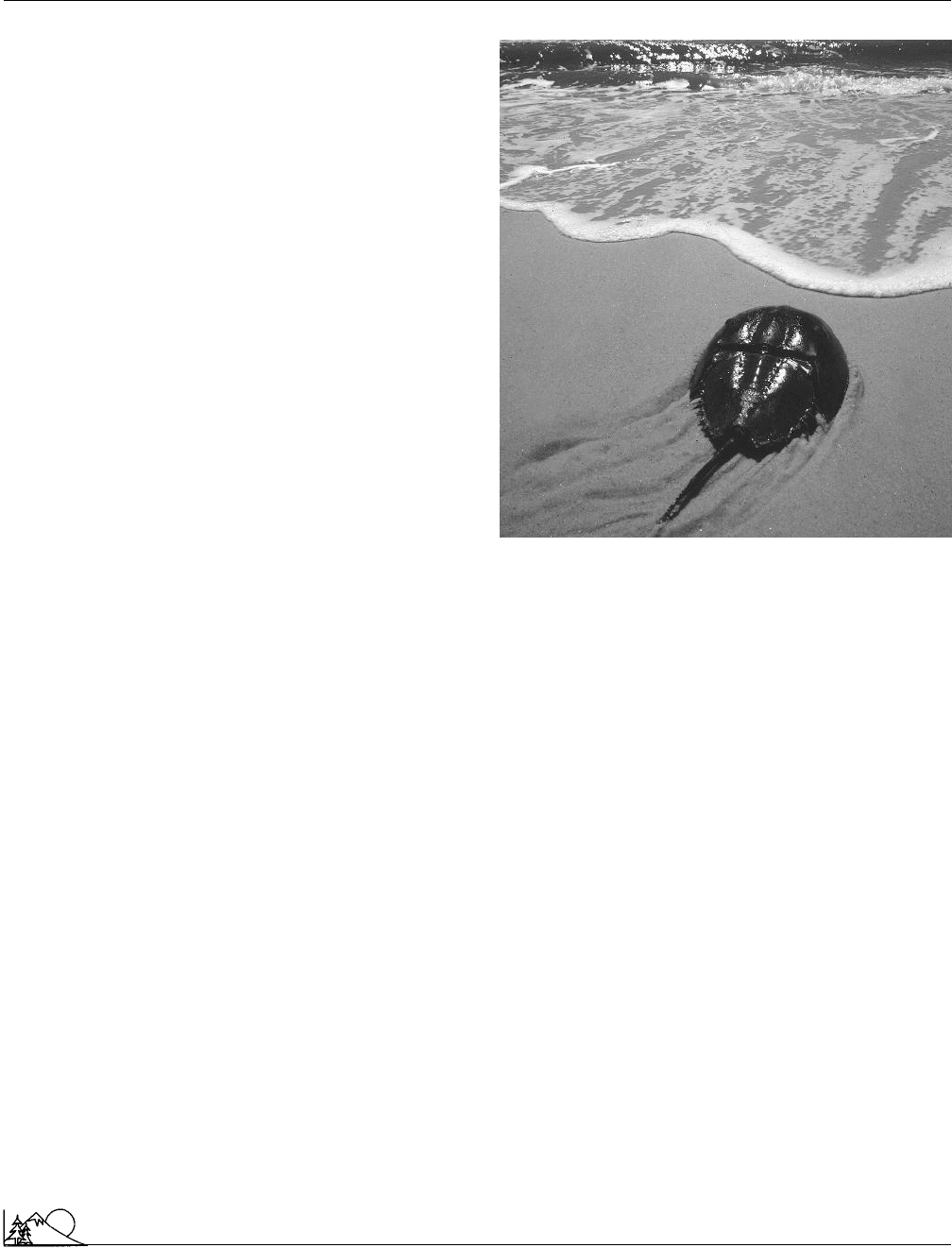Environmental Encyclopedia
Подождите немного. Документ загружается.


Environmental Encyclopedia 3
High-solids reactor
brief controversy when he suggested tearing down O’S-
haughnessy Dam. See also Economic growth and the envi-
ronment; Environmental law; Environmental policy
[Teresa C. Donkin]
R
ESOURCES
B
OOKS
Jones, Holway R. John Muir and the Sierra Club: The Battle for Yosemite.
San Francisco: Sierra Club, 1965.
Nash, Roderick. “Conservation as Anxiety.” In The American Environment:
Readings in the History of Conservation. 2nd ed. Reading, Mass: Addison-
Wesley Publishing Company, 1976.
Heterotroph
A heterotroph is an organism that derives its nutritional
carbon
and energy by oxidizing (i.e., decomposing) organic
materials. The higher animals,
fungi
, actinomycetes, and
most bacteria are heterotrophs. These are the biological con-
sumers that eventually decompose most of the organic matter
on the earth. The
decomposition
products then are available
for chemical or biological
recycling
. See also Biogeochemical
cycles; Oxidation reduction reactions
High-grading (mining, forestry)
The practice of high-grading can be traced back to the early
days of the California gold rush, when miners would sneak
into claims belonging to others and steal the most valuable
pieces of ore. The practice of high-grading remains essen-
tially unchanged today. An individual or corporation will
enter an area and selectively mine or harvest only the most
valuable specimens, before moving on to a new area. High-
grading is most prevalent in the mining and timber indus-
tries. It is not uncommon to walk into a forest, particularly an
old-growth forest
, and find the oldest and finest specimens
marked for harvesting. See also Forest management; Strip
mining
High-level radioactive waste
High-level
radioactive waste
consists primarily of the by-
products of nuclear
power plants
and defense activities.
Such wastes are highly radioactive and often decay very
slowly. They may release dangerous levels of radiation for
hundreds or thousands of years. Most high-level radioactive
wastes have to be handled by remote control by workers who
are protected by heavy shielding. They present, therefore, a
serious health and environmental hazard. No entirely satis-
factory method for disposing of high-level wastes has as yet
717
been devised. Currently, the best approach seems to involve
immobilizing the wastes in a glass-like material and then
burying them deep underground. See also Low-level radioac-
tive waste; Radioactive decay; Radioactive pollution; Radio-
active waste management; Radioactivity
High-solids reactor
Solid waste
disposal is a serious problem in the United
States and other developed countries. Solid waste can consti-
tute valuable raw materials for commercial and industrial
operations, however, and one of the challenges facing scien-
tists is to develop an economically efficient method for utiliz-
ing it.
Although the concept of bacterial waste conversion is
simple, achieving an efficient method for putting the tech-
nique into practice is difficult. The main problem is that
efficiency of conversion requires increasing the ratio of solids
to water in the mixture, and this makes mixing more difficult
mechanically. The high-solids reactor was designed by scien-
tists at the
Solar Energy
Research Institute (SERI) to solve
this problem. It consists of a cylindrical tube on a horizontal
axis, and an agitator shaft running through the middle of
it, which contains a number of Teflon-coated paddles ori-
ented at 90 degrees to each other. The pilot reactors operated
by SERI had a capacity of 2.6 gal (10 l).
SERI scientists modeled the high solids reactor after
similar devices used in the
plastics
industry to mix highly
viscous materials. With the reactor, they have been able to
process materials with 30–35% solids content, while existing
reactors normally handle wastes with five to eight% solid
content. With higher solid content, SERI reactors have
achieved a yield of
methane
five to eight times greater than
that obtained from conventional mixers. Researchers hope
to be able to process wastes with solid content ranging any-
where from zero to 100%. They believe that they can eventu-
ally achieve 80% efficiency in converting
biomass
to
methane.
The most obvious application of the high-solids reac-
tor is the processing of municipal solid wastes. Initial tests
were carried out with
sludge
obtained from
sewage treat-
ment
plants in Denver, Los Angeles, and Chicago. In all
cases, conversion of solids in the sludge to methane was
successful, and other applications of the reactor are also
being considered. For example, it can be used to leach out
uranium
from mine wastes:
anaerobic
bacteria in the reac-
tor will reduce uranium in the wastes and the uranium will
then be absorbed on the bacteria or on
ion exchange
resins.
The use of the reactor to clean
contaminated soil
is also
being considered in the hope is that this will provide a
desirable alternative to current processes for cleaning
soil
,

Environmental Encyclopedia 3
Hiroshima, Japan
which create large volumes of contaminated water. See also
Biomass fuel; Solid waste incineration; Solid waste recycling
and recovery; Solid waste volume reduction; Waste man-
agement
[David E. Newton]
R
ESOURCES
P
ERIODICALS
“High Solids Reactor May Reduce Capital Costs.” Bioprocessing Technology
(June 1990).
“SERI Looking for Partners for Solar-Powered High Solids Reactor.” Waste
Treatment Technology News (October 1990).
High-voltage power lines
see
Electromagnetic field
High-yield crops
see
Borlaug, Norman E.; Consultative
Group on International Agricultural Research
Hiroshima, Japan
Hiroshima is a beautiful modern city located near the south-
western tip of the main Japanese island of Honshu. It had
been a military center with the headquarters of the Japanese
southern army and a military depot prior to the end of World
War II. The city is now a manufacturing center with a
major university and medical school. It is most profoundly
remembered because it was the first city to be exposed to
the devastation of an atomic bomb.
At 8:15
A.M.
on the morning of August 6, 1945, a
single B29 bomber flying in from Tinian Island in the Mari-
nas released the bomb at 2,000 ft (606.6 m) above the city.
The target was a “T"-shaped bridge near the city center.
The only surviving building in the city center after the atomic
bomb blast was a domed cement building at ground zero,
just a few yards from the bridge. An experimental bomb
developed by the Manhattan Project had been exploded at
Alamagardo, New Mexico, only a few weeks earlier. The
Alamagardo bomb had the explosive force of 15,000 tons
of TNT. The Hiroshima uranium-235 bomb, with the ex-
plosive power of 20,000 tons of TNT, was even more power-
ful than the New Mexico bomb. The immediate effect of
the bomb was to destroy by blast, winds, and fire an area
of 4.4 mi
2
(7 km
2
). Two-thirds of the city was destroyed.
A portion of Hiroshima was protected from the blast by
hills, and this is all that remains of the old city. Destruction
of human lives was caused immediately by the blast force
718
of the bomb or by burns or
radiation sickness
later. Sev-
enty-five thousand people were killed or were fatally
wounded; there was an equal number of wounded survivors.
Nagasaki, to the south and west of Hiroshima, was bombed
on August 9, 1945, with much loss of life. The bombing of
these two cities brought World War II to a close. The lessons
that Hiroshima (and Nagasaki) teach are the horrors of war
with its random killing of civilian men, women, and children.
That is the major lesson—war is horrible with its destruction
of innocent lives.
The why of Hiroshima should be taken in the context
of the battle for Okinawa which occurred only weeks before.
America forces suffered 12,000 dead with 36,000 wounded
in the battle for that small island 350 mi (563.5 km) from
the mainland of Japan. The Japanese were reported to have
lost 100,000 men. The determination of the Japanese to
defend their homeland was well known, and it was estimated
that the invasion of Japan would cost no less than 500,000
American lives. Japanese casualties were expected to be
larger. It was the military judgment of the American Presi-
dent that a swift termination of the war would save more
lives than it would cost; both American and Japanese.
Whether this rationale for the atomic bombing of Hiroshima
was correct, i.e., whether more people would have died if
Japan was invaded, will never be known. However, it cer-
tainly is a fact that the war came to a swift end after the
bombing of the two cities.
The second lesson to be learned from Hiroshima is
that
radiation exposure
is hazardous to human health and
radiation damage results in radiation sickness and increased
cancer
risk. It had been known since the development of x
rays at the turn of the century that radiation has the potential
to cause cancer. However, the thousands of survivors at
Hiroshima and Nagasaki were to become the largest group
ever studied for radiation damage. The Atomic Bomb Casu-
alty Commission, now referred to as the Radiation Effects
Research Foundation (RERF), was established to monitor
the health effects of radiation exposure and has studied these
survivors since the end of World War II. The RERF has
reported a 10–15 times excess of all types of
leukemia
among the survivors compared with populations not exposed
to the bomb. The leukemia excess peaked four to seven years
after exposure but still persists among the survivors. All
forms of cancer tended to develop more frequently in heavily
irradiated individuals, especially children under the age of
10 at the time of exposure. Thyroid cancer was also increased
in these children survivors of the bomb.
War is destructive to human life. The particular kind
of destruction at Hiroshima, due to an atomic bomb, contin-
ues to be relentlessly destructive. The city of Hiroshima is
known as a Peace City.
[Robert G. McKinnell]

Environmental Encyclopedia 3
Holistic approach
A painting by Yasuko Yamagata depicting the Japanese city of Hiroshima after the atomic bomb was dropped
on it. (Reproduced by permission.)
Holistic approach
First formulated by Jan Smuts, holism has been traditionally
defined as a philosophical theory that states that the de-
termining factors in
nature
are wholes which are irreducible
to the sum of their parts and that the
evolution
of the
universe is the record of the activity and making of such
wholes. More generally, it is the concept that wholes cannot
be analyzed into parts or reduced to discrete elements with-
out unexplainable residuals. Holism may also be defined by
what it is not: it is not synonymous with organicism; holism
does not require an entity to be alive or even a part of
living processes. And neither is holism confined to spiritual
mysticism, unaccessible to scientific methods or study.
The holistic approach in
ecology
and
environmental
science
derives from the idea proposed by Harrison Brown
that “a precondition for solving [complex] problems is a
realization that all of them are interlocked, with the result
that they cannot be solved piecemeal.” For some scholars
holism is the rationale for the very existence of ecology. As
719
David Gates notes, “the very definition of the discipline of
ecology implies a holistic study.”
The holistic approach has been successfully applied
to environmental management. The United States
Forest
Service
, for example, has implemented a multi-level ap-
proach to management that takes into account the complex-
ity of forest ecosystems, rather than the traditional focus on
isolated incidents or problems.
Some people believe that a holistic approach to nature
and the world will counter the effects of “reductionism"—
excessive individualism, atomization, mechanistic
worldview, objectivism, materialism, and anthropocentrism.
Advocates of holism claim that its emphasis on connectivity,
community, processes, networks, participation, synthesis,
systems, and emergent properties will undo the “ills” of
reductionism. Others warn that a balance between reduc-
tionism and holism is necessary. American ecologist Eugene
Odum mandated that “ecology must combine holism with
reductionism if applications are to benefit society.” Parts and
wholes, at the macro- and micro-level, must be understood.

Environmental Encyclopedia 3
Homeostasis
The basic lesson of a combined and complementary parts-
whole approach is that every entity is both part and whole—
an idea reenforced by Arthur Koestler’s concept of a holon.
A holon is any entity that is both a part of a larger system
and itself a system made up of parts. It is essential to recog-
nize that holism can include the study of any whole, the
entirety of any individual in all its ramifications, without
implying any organic analogy other than organisms them-
selves. A holistic approach alone, especially in its extreme
form, is unrealistic, condemning scholars to an unproductive
wallowing in an unmanageable complexity. Holism and re-
ductionism are both needed for accessing and understanding
an increasingly complex world. See also Environmental ethics
[Gerald L. Young Ph.D.]
R
ESOURCES
B
OOKS
Bowen, W. “Reductions and Holism.” In Thinking About Nature: An Investi-
gation of Nature, Value and Ecology. Athens: University of Georgia Press,
1988.
Johnson, L. E. “Holism.” In A Morally Deep World: An Essay on Moral
Significance and Environmental Ethics. Cambridge: Cambridge University
Press, 1991.
Savory, A. Holistic Resource Management. Covelo, CA: Island Press, 1988.
P
ERIODICALS
Krippner, S. “The Holistic Paradigm.” World Futures 30 (1991): 133–40.
Marietta Jr., D. E. “Environmental Holism and Individuals.” Environmental
Ethics 10 (Fall 1988): 251–58.
McCarty, D. C. “The Philosophy of Logical Wholism.” Synthese 87 (April
1991): 51–123.
Van Steenbergen, B. “Potential Influence of the Holistic Paradigm on the
Social Sciences.” Futures 22 (December 1990): 1071–83.
Homeostasis
Humans, all other organisms, and even ecological systems,
live in an
environment
of constant change. The persistently
shifting, modulating, and changing milieu would not permit
survival, if it were not for the capacity of biological systems
to respond to this constant flux by maintaining a relatively
stable internal environment. An example taken from mam-
malian biology is temperature which appears to be “fixed”
at approximately 98.6°F (37°C). While humans can be ex-
posed to extreme summer heat, and arctic mammals survive
intense cold, body temperature remains constant within vary
narrow limits. Homeostasis is the sum total of all the biologi-
cal responses that provide internal equilibrium and assure
the maintenance of conditions for survival.
The human
species
has a greater variety of living
conditions than any other organism. The ability of humans
to live and reproduce in such diverse circumstances is due
720
to a combination of homeostatic mechanisms coupled with
cultural (behavioral) responses.
The scientific concept of homeostasis emerged from
two scientists: Claude Bernard, a French physiologist, and
Walter Bradford Cannon, an American physician. Bernard
contrasted the external environment which surrounds an
organism and the internal environment of that organism.
He was, of course, aware that the external environment
fluctuated considerably in contrast to the internal environ-
ment which remained remarkably constant. He is credited
with the enunciation of the constancy of the internal environ-
ment ("La fixite
´
du milieu inte
´
rieur...") in 1859. Bernard
believed that the survival of an organism depended upon
this constancy, and he observed it not only in temperature
control but in the regulation of all of the systems that he
studied. The concept of the stable “milieu inte
´
rieur” has been
accepted and extended to the many organ systems of all
higher vertebrates. This precise control of the internal envi-
ronment is effected through hormones, the autonomic ner-
vous system, endocrines, etc.
The term “homeostasis,” derived from the Greek ho-
moios meaning similar and stasis meaning to stand, suggests
an internal environment which remains relatively similar or
the same through time. The term was devised by Cannon
in 1929 and used many times subsequently. Cannon noted
that, in addition to temperature, there were complex controls
involving many organ systems that maintained the internal
stability
within narrow limits. When those limited are ex-
ceeded, there is a reaction in the opposite direction that
brings the condition back to normal, and the reactions re-
turning the system to normal is referred to as negative feed-
back. Both Bernard and Cannon were concerned with hu-
man physiology. Nevertheless, the concept of homeostasis
is applied to all levels of biological organization from the
molecular level to ecological systems, including the entire
biosphere
. Engineers design self-controlling machines
known as servomechanisms with feedback control by means
of a sensing device, an amplifier which controls a servomotor
which in turn runs the operation of the device. Examples
of such devices are the thermostats which control furnace
heat in a home or the more complicated automatic pilots
of aircraft. While the human-made servomechanisms have
similarities to biological homeostasis, they are not consid-
ered here.
As indicated above, temperature is closely regulated
in humans and other homeotherms (birds and mammals).
The human skin has thermal receptors sensitive to heat or
cold. If cold is encountered, the receptors notify an area of
the brain known as the hypothalamus via a nerve impulse.
The hypothalamus has both a heat-promoting center and a
heat-losing center, and, with cold, it is the former which
is stimulated. Thyroid-releasing hormone, produced in the

Environmental Encyclopedia 3
Homeostasis
hypothalamus, causes the anterior pituitary to release thyroid
stimulating hormone which, in turn, causes the thyroid gland
to increase production of thyroxine which results in increased
metabolism
and therefore heat. Sympathetic nerves from
the hypothalamus stimulate the adrenal medulla to secrete
epinephrine and norepinephrine into the blood which also
increases body metabolism and heat. Increased muscle activ-
ity will generate heat and that activity can be either voluntary
(stamping the feet for instance) or involuntary (shivering).
Since heat is dissipated via body surface blood vessels, the
nervous system causes surface vasoconstriction to decrease
that heat loss. Further, the small quantity of blood that does
reach the surface of the body, where it is chilled, is reheated
by countercurrent heat exchange resulting from blood vessels
containing cold blood from the limbs running adjacent to
blood vessels from the body core which contain warm blood.
The chilled blood is prewarmed prior to returning to the
body core. A little noted response to chilling is the voluntary
reaching for a jacket or coat to minimize heat loss.
The body responds with opposite results when exces-
sive heat is encountered. The individual tends to shed unnec-
essary clothing, and activity is reduced to minimize metabo-
lism. Vasodilation of superficial blood vessels allows for
radiation of heat. Sweat is produced, which by evaporation
reduces body heat. It is clear that the maintenance of body
temperature is closely controlled by a complex of homeostasis
mechanisms.
Each step in temperature regulation is controlled by
negative feedback. As indicated above, with exposure to cold
the hypothalamus, through a series of steps, induces the
synthesis and release of thyroxine by the thyroid gland. What
was not indicated above was the fact that elevated levels of
thyroxine control the level of activity of the thyroid by nega-
tive feedback inhibition of thyroid stimulating hormone. An
appropriate level of thyroid hormone is thus maintained. In
contrast, with inadequate thyroxine, more thyroid stimulat-
ing hormone is produced. Negative feedback controls assure
that any particular step in homeostasis does not deviate too
much from the normal.
Historically, biologists have been particularly impres-
sed with mammalian and human homeostasis. Lower verte-
brates have received less attention. However, while internal
physiology may vary more in a frog than in a human, there
are mechanisms which assure the survival of
frogs
. For
instance, when the ambient temperature drops significantly
in the autumn in northern latitudes, leopard frogs move into
lakes or rivers which do not freeze. Moving into lakes and
rivers is a behavioral response to a change in the external
environment which results in internal temperature stability.
The metabolism and structure of the frog is inadequate to
protect the frog from freezing, but the specific heat of the
water is such that freezing does not occur except at the
721
surface of the overwintering lake or river. Even though life
at the bottom of a lake with an ice cover moves at a slower
pace than during the warm summer months, a functioning
circulatory system is essential for survival. In general, frog
blood (not unlike crankcase oil prior to the era of multiviscos-
ity oil) increases in viscosity with as temperature decreases.
Frog blood, however, decreases in viscosity with the pro-
longed autumnal and winter cold temperatures, thus assuring
adequate circulation during the long nights under an ice
cover. This is another control mechanism that assures the
survival of frogs by maintaining a relatively stable internal
environment during the harsh winter. With a return of a
warm external environment, northern leopard frogs leave
cold water to warm up under the spring sun. Warm tempera-
ture causes frog blood viscosity to increase to summer levels.
It may be that the behavioral and physiological changes do
not prevent oscillations that would be unsuitable for warm
blooded animals but, in the frog, the fluctuations do not
interfere with survival, and in biology, that is all that is
essential.
There is homeostasis in ecological systems. Popula-
tions of animals in complex systems fluctuate in numbers,
but the variations in numbers are generally between limits.
For example, predators survive in adequate numbers as long
as prey are available. If predators become too great in num-
ber, the population of prey will diminish. With fewer prey,
the numbers of predators plummet through negative feed-
back thus permitting recovery of the preyed upon species.
The situation becomes much more complex when other food
sources are available to the predator.
Many organisms encounter a negative feedback on
growth rate with crowding. This density dependent popula-
tion control has been studied in larval frogs, as well as many
other organisms, where excretory products seem to specifi-
cally inhibit the crowded species but not other organisms in
the same environment. Even with adequate food, high den-
sity culture of laboratory mice results in negative feedback
on reproductive potential with abnormal gonad development
and delayed sexual maturity. Density independent factors
affecting populations are important in population control
but would not be considered homeostasis.
Drought
is such
a factor, and its effects can be contrasted with crowding.
Populations of tadpoles will drop catastrophically when
breeding ponds dry. Instead of fluctuating between limits
(with controls), all individuals are affected the same (i.e.,
they die). The area must be repopulated with immigrants
at a subsequent time, and the
migration
can be considered
a population homeostatic control. The inward migration
results in maintenance of population within the geographic
area and aids in the survival of the species.
[Robert G. McKinnell]

Environmental Encyclopedia 3
Homestead Act (1862)
R
ESOURCES
B
OOKS
Hardy, R. N. Homeostasis. London: Edward Arnold, Ltd., 1976.
Langley, L. L. Homeostasis. New York: Reinhold Publishing Co., 1965.
Tortora, G. J., and N. P. Anagnostakos. Principles of Anatomy and Physiology.
5th ed. New York: Harper and Row, 1987.
Homestead Act (1862)
The Homestead Act was signed into law in 1862. It was
a legislative offer on a vast scale of free homesteads on
unappropriated public lands. Any citizen (or alien who filed
a declaration of intent to become a citizen), who had reached
the age of 21, and was the head of a family could acquire
title to a stretch of
public land
of up to 160 acres (65 ha)
after living on it and farming it for five years. The only
payment required was administrative fees. The settler could
also obtain the land without the requirement of residence
and cultivation for five years, against payment of $1.25 per
acre. With the advent of machinery to mechanize farm labor,
160-acre (65 ha) tracts soon became uneconomical to oper-
ate, and Congress modified the original act to allow acquisi-
tion of larger tracts. The Homestead Act is still in effect,
but good unappropriated land is scarce. Only Alaska still
offers opportunities for homesteaders.
The Homestead Act was designed to speed develop-
ment of the United States and to achieve an equitable distri-
bution of wealth. Poor settlers, who lacked the capital to
buy land, were now able to start their own farms. Indeed,
the act contributed greatly to the growth and development
of the country, particularly in the period between the Civil
War and World War I, and it did much to speed settlement
west of the Mississippi River. In all, well over a quarter
of a billion acres of land has been distributed under the
Homestead Act and its amendments. However, only a small
percentage of land granted under the act between 1862 and
1900 was in fact acquired by homesteaders. According to
estimates, only at most 1 of every 6 acres (0.4 of every 2.4
ha) and possibly only 1 in 9 acres (0.4 in 3.6 ha) passed into
the hands of family farmers.
The railroad companies and land speculators obtained
the bulk of the land, sometimes through gross fraud using
dummy entrants. Moreover, the railroads often managed to
get the best land while the homesteaders, ignorant of farming
conditions on the Plains, often ended up with tracts least
suitable to farming. Speculators frequently encouraged set-
tlement on land that was too dry or had no sources of water
for domestic use. When the homesteads failed, many settlers
sold the land to speculators.
The environmental consequences of the Homestead
Act were many and serious. The act facilitated railroad devel-
722
opment, often in excess of
transportation
needs. In many
instances, competing companies built lines to connect the
same cities. Railroad development contributed significantly
to the destruction of
bison
herds, which in turn led to the
destruction of the way of life of the Plains Indians. Cultiva-
tion of the Plains caused wholesale destruction of the vast
prairies, so that whole ecological systems virtually disap-
peared. Overfarming of semi-arid lands led to another envi-
ronmental disaster, whose consequences were fully experi-
enced only in the 1930s. The great
Dust Bowl
, with its
terrifying dust storms, made huge areas of the country un-
livable.
The Homestead Act was based on the notion that
land held no value unless it was cultivated. It has now become
clear that reckless cultivation can be self-destructive. In many
cases, unfortunately, the damage can no longer be undone.
[William E. Larson and Marijke Rijsberman]
R
ESOURCES
P
ERIODICALS
Shimkin, M. N. “Homesteading on the Republican River.” Journal of the
West 26 (October 1987): 58–66.
Horizon
Layers in the
soil
develop because of the additions, losses,
translocations, and transformations that take place as the
soil ages. The soil layers occur as a result of water percolating
through the soil and
leaching
substances downward. The
layers are parallel to the soil surface and are called horizons.
Horizons will vary from the surface to the
subsoil
and from
one soil to the next because of the different intensities of
the above processes. Soils are classified into different groups
based on the characteristics of the horizons.
Horseshoe crabs
The horseshoe crab (Limulus polyphemus) is the American
species
of a marine animal that is only a distant relation of
crustaceans like crabs and lobsters. Horseshoe crabs are more
closely related to spiders and scorpions. The crabs have been
called “living fossils” because the genus dates back millions
of years, and Limulus evolved very little over the years.
Fossils found in British Columbia indicate that the
ancestors of horseshoe crabs were in North America about
520 million years ago. During the late twentieth century,
the declining horseshoe crab population concerned environ-
mentalists. Horseshoe crabs are a vital food source for dozens
of species of birds that migrate from South America to the
Arctic Circle. Furthermore, crabs are collected for medical

Environmental Encyclopedia 3
Horseshoe crabs
research. After blood is taken from the crabs, they are re-
turned to the ocean.
American horseshoe crabs live along the Atlantic
Ocean coastline. Crab
habitat
extends south from Maine
to the Yucata
´
n in the Gulf of Mexico. Several other crab
species are found in Southeast Asia and Japan.
The American crab is named for its helmet-like shell
that is shaped like a horseshoe. Limulus has a sharp tail
shaped like a spike. The tail helps the crab move through
the sand. If the crab tips over, the tail serves as a rudder so
the crab can get back on its feet. The horseshoe crab is
unique; its blood is blue and contains
copper
. The blood
of other animals is red and contains iron.
Mature female crabs measure up to 24 inches in length.
Males are about two-thirds smaller. Horseshoe crabs can
live for 19 years, and they reach sexual maturity in 10 years.
The crabs come to shore to spawn in late May and early
June. They spawn the during the phases of the full and new
moon. The female digs nests in the sand and deposits from
200 to 300 eggs in each pit. The male crab fertilizes the
eggs with sperm, and the egg clutch is covered with sand.
During the spawning season, a female crab could de-
posit as many as 90,000 eggs. This spawning process coin-
cides with the
migration
of shorebirds. Flocks of birds like
the red knot and the sandpiper eat their fill of crab eggs
before continuing their northbound migration.
Through the years, people found a variety of uses
for horseshoe crabs. During the sixteenth century, Native
Americans in South Carolina attached the tails to the spears
that they used to catch fish. In the nineteenth century, people
ground the crabs up for use as
fertilizer
or food for chickens
and hogs.
During the twentieth century, researchers learned
much about the human eye by studying the horseshoe crab’s
compound eye. Furthermore, researchers discovered that the
crab’s blood contained a special clotting agent that could be
used to test the purity of new drugs and intravenous solu-
tions. The agent called Limulus Amoebocyte Lysate is obtained
by collecting horseshoe crabs during the spawning season.
Crabs are bled and then returned to the beach.
Horseshoe crabs are also used as bait. The harvesting
of crabs increased sharply during the 1990s when people in
the fishing industry used crabs as bait to catch eels and
conch. The annual numbers of crabs harvested jumped from
the thousands to the millions during the 1990s, according
to environmental groups and organizations like the
National
Audubon Society
.
The declining horseshoe crab population could affect
millions of migrating birds. The Audubon Society reported
seeing fewer birds at the Atlantic beaches where horseshoe
723
A horseshoe crab (
Limulus polyphemus
). (©John
M. Burnley, National Audubon Society Collection. Photo
Researchers Inc. Reproduced by permission.)
crabs spawn. In the spring of 2000, scientists said that birds
appeared undernourished. Observers doubted that they
would complete their journey to the Arctic Circle.
The Audubon Society and environmental groups have
campaigned for state and federal regulations to protect horse-
shoe crabs. By 2002, coastal states and the Atlantic States
Marine Fisheries Commission had set limits on the amount
of crabs that could be harvested. The state of Virginia made
bait bags mandatory when fishing with horseshoe crab bait.
The mesh bag made of hard plastic holds the crab. That
made it more difficult for predators to eat the crab so fewer
Limuluscrabs were needed as bait.
Furthermore, the federal government created a 1,500-
square-mile refuge for horseshoe crabs in Delaware Bay.
The refuge extends from Ocean City, New Jersey to north
of Ocean City, Maryland. As of March of 2002, harvesting
was banned in the refuge. People who took crabs from the
area faced a fine of up to $100,000, according to the National
Marine Fisheries Service.
As measures like those were enacted, marine biologists
said that it could be several decades before the crab popula-
tion increased. One reason for slow
population growth
was that it takes crabs 10 years to reach maturity.
[Liz Swain]

Environmental Encyclopedia 3
Household waste
R
ESOURCES
B
OOKS
Fortey, Richard. Trilobite!: Eyewitness to Evolution. New York: Alfred A.
Knopf, 2000.
Tanacredi, John, Ed. Limulus in the Limelight: 350 Million Years in the
Making and in Peril? New York: Kluwer Academic Publishers, 2001.
O
RGANIZATIONS
Atlantic States Marine Fisheries Commission., 1444 Eye Street, NW, Sixth
Floor, Washington, D.C. 20005 (202) 289-6400, Fax: (202) 289-6051,
Email: comments@asmfc.org, http://www.asmfc.org
National Audubon Society Horseshoe Crab Campaign., 1901 Pennsylvania
Avenue NW, Suite 1100, Washington, D.C. 20006 (202) 861-2242, Fax:
(202) 861-4290, Email: pplumart@audubon.org, http://www.audubon.org/
campaign/horseshoe/contacts.htm
National Marine Fisheries Service., 1315 East West Highway, SSMC3,
Silver Spring, MD 20910 (301) 713-2334, Fax: (301) 713-0596, Email:
cyber.fish@noaa.gov, hhttp://www.nmfs.noaa.gov
Hospital wastes
see
Medical waste
Household waste
Household waste is commonly referred to as
garbage
or
trash. As the population of the world expands, so does the
amount of waste produced. Generally, the more automated
and industrialized human societies become, the more waste
they produce. For example, the industrial revolution intro-
duced new manufactured products and new manufacturing
processes that added to household
solid waste
and indus-
trial waste. Modern consumerism and the excess packaging
of many products also contribute significantly to the increas-
ing amount of solid waste.
Much of the trash Americans produce (about 40%) is
paper and paper products. Paper accounts for more than 71
million tons of garbage. Yard wastes are the next most com-
mon waste, contributing more than 31 million tons of solid
waste. Metals account for more than 8% of all household
waste, and
plastics
are close behind with another 8% or 14
million tons. America’s trash also contains about 7% glass
and nearly 20 million tons of other materials like
rubber
,
textiles, leather, wood, and inorganic wastes. Much of the
waste comes from packaging materials. Other types of waste
produced by consumers are durable goods such as tires,
appliances, and furniture, while other household solid waste
is made up of non-durable goods such as paper, disposable
products, and clothing. Many of these items could be recy-
cled and reused, so they also can be considered a non-utilized
resource.
In less industrialized times and even today in many
developing countries, households and industries disposed of
unwanted materials in bodies of water or in land dumps.
724
However, this practice creates undesirable effects such as
health hazards and foul odors. Open dumps serve as breeding
grounds for disease-carrying organisms such as rats and in-
sects. As the
first world
became more alert to environmental
hazards, methods for waste disposal were studied and im-
proved. Today, however, governments, policymakers, and
individuals still wrestle with the problem of how to improve
methods of waste disposal, storage, and
recycling
.
In 1976, the United States Congress passed the
Re-
source Conservation and Recovery Act
(RCRA) in an
effort to protect human health and the
environment
from
hazards associated with waste disposal. In addition, the act
aims to conserve energy and
natural resources
and to re-
duce the amount of waste Americans generate. Further, the
RCRA promotes methods to manage waste in an environ-
mentally sound manner. The act covers regulation of solid
waste,
hazardous waste
, and underground storage tanks
that hold
petroleum
products and certain
chemicals
.
Most household solid waste is removed from homes
through community garbage collection and then taken to
landfills. The garbage in landfills is buried, but it can still
produce noxious odors. In addition, rainwater can seep
through
landfill
sites and leach out pollutants from the
landfill trash. These are then carried into nearby bodies of
water. Pollutants can also contaminate
groundwater
, which
in turn leads to contamination of drinking water.
In order to fight this problem, sanitary landfills were
developed. Clay or plastic liners are placed in the ground
before garbage is buried. This helps prevent water from
seeping out of the landfill and into the surrounding environ-
ment. In sanitary landfills, each time a certain amount of
waste is added to the landfill, it is covered by a layer of
soil
.
At a predetermined height the site is capped and covered
with dirt. Grass and trees can be planted on top of the
capped landfill to help prevent
erosion
and to improve the
look of the site. Sanitary landfills are more expensive than
open pit dumps, and many communities do not want the
stigma of having a landfill near them. These factors make
it politically difficult to open new landfills. Landfills are
regulated by state and local governments and must meet
minimum requirements set by the United States
Environ-
mental Protection Agency
(EPA). Some household haz-
ardous wastes such as paint, used motor oil, or insecticides
can not be accepted at landfills and must be handled sepa-
rately.
Incineration
(burning) of solid waste offers an alterna-
tive to disposal in landfills. Incineration converts large
amounts of solid waste to smaller amounts of ash. The ash
must still be disposed of, however, and it can contain toxic
materials. Incineration released
smoke
and other possible
pollutants into the air. However, modern incinerators are
equipped with smokestack
scrubbers
that are quite effective

Environmental Encyclopedia 3
Hubbard Brook Experimental Forest
in trapping toxic emissions. Many incinerators have the
added benefit of generating electricity from the trash they
burn.
Composting
is a viable alternative to landfills and
incineration for some
biodegradable
solid waste. Vegetable
trimmings, leaves, grass clippings, straw, horse manure,
wood chippings, and similar plant materials are all biode-
gradable and can be composted. Compost helps the environ-
ment because it reduces the amount of waste going into
landfills. Correct composting also breaks down biodegrad-
able material into a nutrient-rich soil additive that can be
used in gardens or for landscaping. In this way, nutrients vital
to plants are returned to the environment. To successfully
compost biodegradable wastes, the process must generate
high enough temperatures to kill seeds or organisms in the
composted material. If done incorrectly, compost piles can
give off foul odors.
Families and communities can help reduce household
waste by making some simple lifestyle changes. They can
reduce solid waste by recycling, repairing rather than replac-
ing durable goods, buying products with minimal packaging,
and choosing packaging made from recycled materials. Re-
ducing packaging material is an example of source reduction.
Much of the responsibility for source reduction with manu-
facturers. Businesses need to be encouraged to find smart
and cost effective ways to manufacture and package goods
in order to minimize waste and reduce the toxicity of the
waste created. Consumers can help by encouraging compa-
nies to create more environmentally responsible packaging
through their choice of products. For example, consumers
successfully pressured McDonalds to change from serving
their sandwiches in non-biodegradable Styrofoam boxes to
wrapping them in biodegradable paper.
For individual households can reduce the amount of
waste they send to landfills by recycling. Paper,
aluminum
,
glass, and plastic containers are the most commonly recycled
household materials. Strategies for household recycling vary
from community to community. In some areas materials
must separated by type before collection. In others, the sepa-
ration occurs after collection.
Recycling preserves natural resources by providing an
alternative supply of raw materials to industries. It also saves
energy and eliminates the emissions of many toxic gases and
water pollutants. In addition, recycling helps create jobs,
stimulates development of more environmentally sound
technologies, and conserves resources for
future genera-
tions
. For recycling to be successful, there must be an end
market for goods made from recycled materials. Consumers
can support recycling by buying “green” products made of
recycled materials.
Battery recycling
is also becoming increasingly com-
mon in the United States and is required by law in many
725
European countries. In 2001, a nonprofit organization called
Rechargeable Battery Recycling Corporation (RBRC) began
offering American communities cost-free recycling of porta-
ble rechargeable batteries such as those used in cell phones,
camcorders, and laptop computers. These batteries contain
cadmium
, which is recycled back into other batteries or
used in certain coatings or color pigments.
Household waste disposal is an international problem
that is being attacked in many ways in many countries. In
Tripoli, Libya, a plant exploits household waste, converting
it to organic
fertilizer
. The plant recycles 500 tons of house-
hold waste, producing 212 tons of fertilizer a day. In France,
a country with less available space for landfills than the
United States, incineration is proving a desirable alternative.
The French are turning household waste into energy through
combustion
and are developing technologies to control the
residues that occur from incineration.
In the United States, education of consumers is a key
to reducing the volume and toxicity of household waste. The
EPA promotes four basic principles for reducing solid waste:
reduce the amount of trash discarded,
reuse
products and
containers, recycle and compost, and reconsider activities
that produce waste.
[Teresa G. Norris]
R
ESOURCES
O
THER
“Communities Invited to Recycle Rechargables Cost Free.” Environmental
News Network. October 11, 2001 [cited July 2002]. <http://www.enn.-
com/news>.
O
RGANIZATIONS
U.S. Environmental Protection Agency Office of Solid Waste, 1200
Pennsylvania Avenue NW, Washington, DC USA 20460 (703) 412-9810,
Toll Free: (800) 424-9346, , <http://www.epa.gov>
HRS
see
Hazard Ranking System
Hubbard Brook Experimental Forest
The Hubbard Brook Experimental Forest is located in West
Thornton, New Hampshire. It is an experimental area estab-
lished in 1955 within the White Mountains
National Forest
in New Hamphire’s central plateau and is administered by
the U.S.
Forest Service
. Hubbard Brook was the site of
many important ecological studies beginning in the 1960s
which established the extent of
nutrient
losses when all the
trees in a
watershed
are cut.
Hubbard Brook is a north temperate watershed cov-
ered with a mature forest, and it is still accumulating
bio-

Environmental Encyclopedia 3
Hudson River
mass
. In one early study, vegetation cut in a section of
Hubbard Brook was left to decay while nutrient losses were
monitored in the
runoff
. Total
nitrogen
losses in the first
year were twice the amount cycled in the system during a
normal year. With the rise of nitrate in the runoff, concentra-
tions of calcium, magnesium, sodium, and potassium rose.
These increases caused eutrophication and
pollution
of the
streams fed by this watershed. Once the higher plants had
been destroyed, the
soil
was unable to retain nutrients.
Early evidence from the studies indicated that total
losses in the
ecosystem
due to the
clear-cutting
were a
large number of the total inventory of
species
. The site’s
ability to support complex living systems was reduced. The
lost nutrients could accumulate again, but
erosion
of pri-
mary minerals would limit the number of plants and animals
sustained in the area.
Another study at the Hubbard Brook site investigated
the effects of forest cutting and
herbicide
treatment on
nutrients in the forest. All of the vegetation in one of Hub-
bard Brook’s seven watersheds was cut and then the area
was treated with the herbicides. At the time the conclusions
were startling:
deforestation
resulted in much larger runoffs
into the streams. The
pH
of the
drainage
stream went from
5.1 to 4.3, along with a change in temperature and electrical
conductivity of the stream water. A combination of higher
nutrient concentration, higher water temperature, and
greater solar radiation due to the loss of forest cover produced
an
algal bloom
, the first sign of eutrophication. This sig-
naled that a change in the ecosystem of the watershed had
occurred. It was ultimately demonstrated at Hubbard Brook
that the use of herbicides on a cut area resulted in their
transfer to the outgoing water.
Hubbard Brook Experimental Forest continues to be
an active research facility for foresters and biologists. Most
current research focuses on
water quality
and nutrient ex-
change. The Forest Service also maintians an
acid rain
monitoring station, and conducts research on old-growth
forests. The results from various studies done at Hubbard
Brook have shown that mature forest ecosystems have a
greater ability to trap and store nutrients for
recycling
within
the ecosystem. In addition, mature forests offer a higher
degrees of
biodiversity
than do forests that are clear-cut.
See also Aquatic chemistry; Cultural eutrophication; Decline
spiral; Experimental Lakes Area; Nitrogen cyle
[Linda Rehkopf]
R
ESOURCES
B
OOKS
Bormann, F. H. Pattern and Process in a Forested Ecosystem: Disturbance
Development and the Steady State Based on the Hubbard Brook Ecosystem
Study. New York: Springer-Verlag, 1991.
726
Botkin, D. B. Forest Dynamics: An Ecological Model. New York: Oxford
University Press, 1993.
P
ERIODICALS
Miller, G. “Window Into a Water Shed.” American Forests 95 (May-June
1989): 58–61.
Hudson River
Starting at Lake Tear of the Clouds, a two-acre (0.8-ha)
pond in New York’s
Adirondack Mountains
, the Hudson
River runs 315 miles (507 km) to the Battery on Manhattan
Island’s southern tip, where it meets the Atlantic Ocean.
Although polluted and extensively dammed for hydroelectric
power, the river still contains a wealth of aquatic
species
,
including massive sea sturgeon (Acipenser oxyrhynchus) and
short-nosed sturgeon (A. brevirostrum). The upper Hudson is
fast-flowing trout stream, but below the Adirondack Forest
Preserve,
pollution
from municipal sources, paper compa-
nies, and industries degrades the water. Stretches of the
upper Hudson contain so-called warm water fish, including
northern pike (Esox lucius), chain pickerel (E. niger),
smallmouth bass (Micropterus dolomieui), and largemouth
bass (M. salmoides). These latter two fish swam into the
Hudson through the
Lake Erie
and Lake Champlain canals,
which were completed in the early nineteenth century.
The Catskill Mountains dominate the mid-Hudson
region, which is rich in fish and
wildlife
, though dairy
farming, a source of
runoff
pollution, is strong in the region.
American shad (Alosa sapidissima), historically the Hudson’s
most important commercial fish, spawn on the river flats
between Kingston and Coxsackie. Marshes in this region
support snapping turtles (Chelydra serpentina) and, in the
winter, muskrat (Ondatra zibethicus) and mink (Mustela vi-
son). Water chestnuts (Trapa natans) grow luxuriantly in
this section of the river.
Deep and partly bordered by mountains, the lower
Hudson resembles a fiord. The unusually deep lower river
makes it suitable for navigation by ocean-going vessels for
150 miles (241 km) upriver to Albany. Because the river’s
surface elevation does not drop between Albany and Man-
hattan, the tidal effects of the ocean are felt all the way
upriver to the Federal Lock and Dam above Albany. These
powerful tides make long stretches of the lower Hudson
saline or
brackish
, with saltwater penetrating as high as 60
miles (97 km) upstream from the Battery.
The Hudson contains a great variety of botanical spe-
cies. Over a dozen oaks thrive along its banks, including red
oaks (Quercus rubra), black oaks (Q. velutina), pin oaks (Q.
palustris), and rock chestnut (Q. prinus). Numerous other
trees also abound, from mountain laurel (Kalmia latifolia)
and red pine (Pinus resinosa) to flowering dogwood (Cornus
